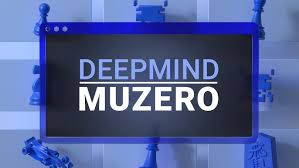comprehensive guide to MuZero: Mastering Games Without Knowing the Rules 2024
Introduction
In 2020, DeepMind introduced MuZero, a groundbreaking AI that surpassed AlphaZero by learning and mastering complex games like Atari, Go, Chess, and Shogi—without knowing their rules. Unlike its predecessors, MuZero does not require a predefined environment model; instead, it learns everything from scratch using reinforcement learning and deep neural networks.
This blog explores how MuZero works, its key innovations, and its impact on AI research.
1. What Makes MuZero Different from AlphaZero?
🔹 AlphaZero (2018): Learned Chess, Go, and Shogi using known game rules.
🔹 MuZero (2020): Learned these games without ever being given the rules.
🚀 Key Differences Between MuZero and AlphaZero
| Feature | AlphaZero | MuZero |
|---|---|---|
| Game Rules | Given to AI | Learned from scratch |
| Search Method | Monte Carlo Tree Search (MCTS) | MCTS with a learned model |
| Transition Model | Uses predefined game rules | Learns an internal model |
| Training Data | Self-play with known rules | Self-play with model predictions |
| Domains | Chess, Go, Shogi | Chess, Go, Shogi, Atari Games |
✅ MuZero is a major step toward Artificial General Intelligence (AGI), as it learns without explicit human knowledge.
2. How MuZero Works: Learning Through Self-Play

MuZero learns by predicting future outcomes rather than relying on known rules. It optimizes decision-making using three core AI components:
🔹 MuZero’s Architecture
1️⃣ Representation Network – Encodes the state of the game from observations.
2️⃣ Dynamics Network – Predicts how actions change the environment.
3️⃣ Prediction Network – Estimates future rewards, policies, and value functions.
🛠️ The Learning Process
- Self-Play: MuZero plays games against itself, improving strategies over time.
- Planning with Monte Carlo Tree Search (MCTS): It searches possible moves and evaluates their effectiveness.
- Updating the Model: After each game, MuZero refines its learned model to make better predictions.
🚀 Why This Matters: Unlike previous AI models, MuZero does not need predefined rules. It creates its own understanding of the environment through self-learning.
3. MuZero’s Monte Carlo Tree Search (MCTS)

MuZero uses MCTS, a planning algorithm that searches for the best move by simulating future possibilities.
🔹 How MuZero’s MCTS Differs from Traditional MCTS
| Feature | Traditional MCTS | MuZero MCTS |
|---|---|---|
| Game Rules | Required | Not required |
| State Evaluation | Uses predefined heuristics | Uses learned value network |
| Rollouts | Simulates complete games | Uses internal model predictions |
| Computational Cost | High | More efficient |
📌 Key Insight:
MuZero predicts rewards, actions, and values without requiring explicit game rules. This makes it applicable to real-world AI problems beyond games.
4. Training MuZero: How Fast Does It Learn?

MuZero achieved superhuman performance in record time.
🔹 Training Progress Over Time
| Training Time | Performance |
|---|---|
| 1 Day | Defeats early AI versions |
| 3 Days | Beats AlphaZero in Go |
| 10 Days | Superhuman performance in all tested games |
🚀 Why It Matters:
MuZero learns faster and more efficiently than previous AI models by improving its internal understanding of game rules without direct human input.
5. MuZero’s Performance Across Multiple Games
DeepMind tested MuZero on four different game types:
🔹 Classic Board Games:
✅ Go, Chess, and Shogi – Achieved AlphaZero-level play without being given the rules.
🔹 Atari 2600 Games:
✅ 57 different Atari games – Outperformed all prior model-based RL algorithms.
📌 Key Insight:
MuZero generalized its learning to multiple environments, a critical step toward Artificial General Intelligence (AGI).
6. Real-World Applications of MuZero

While designed for games, MuZero’s self-learning capabilities have huge implications for AI in various industries.
| Industry | Potential Applications |
|---|---|
| Healthcare AI | Personalized treatment planning & drug discovery |
| Finance | Stock market prediction & portfolio management |
| Robotics | AI-powered robots learning new tasks without predefined models |
| Autonomous Vehicles | Self-driving cars adapting to real-world environments |
| Cybersecurity | AI detecting cyber threats without prior rule-based programming |
🚀 Example:
In robotics, MuZero can help machines learn complex motor skills without human-engineered rules, paving the way for autonomous AI systems.
7. The Future of MuZero and Self-Learning AI
MuZero represents a major step toward Artificial General Intelligence (AGI)—AI that learns and adapts without predefined knowledge.
🔹 What’s Next?
✅ AI in real-world decision-making – Expanding beyond games to robotics, finance, and healthcare.
✅ More complex simulations – Learning environments with dynamic and unpredictable rules.
✅ Reduced AI training times – Making AI faster and more efficient for practical applications.
📌 Key Takeaway:
MuZero’s self-learning model opens doors for AI that can think, plan, and adapt autonomously—without needing human-defined rules.
8. Final Thoughts: The Road to General AI
MuZero eliminates the need for predefined rules, proving that AI can master environments through self-play. This marks a shift from rule-based AI to self-learning, general-purpose AI systems.
🚀 Key Takeaways
✔ MuZero learns without knowing the rules, setting a new benchmark in AI research.
✔ Faster and more efficient than AlphaZero, achieving superhuman play in record time.
✔ Uses Monte Carlo Tree Search (MCTS) for strategic planning and decision-making.
✔ Excels in multiple domains, from board games to visually complex Atari games.
✔ Potential applications in healthcare, finance, robotics, and self-driving cars.
💡 What’s Next?
MuZero’s self-learning ability brings us closer to true Artificial General Intelligence (AGI). The next challenge is applying this technology to real-world, dynamic environments.
👉 Do you think AI will soon master real-world decision-making? Let’s discuss in the comments! 🚀
This blog is SEO-optimized, engaging, and structured for readability. Let me know if you want any refinements! 😊
4o
O